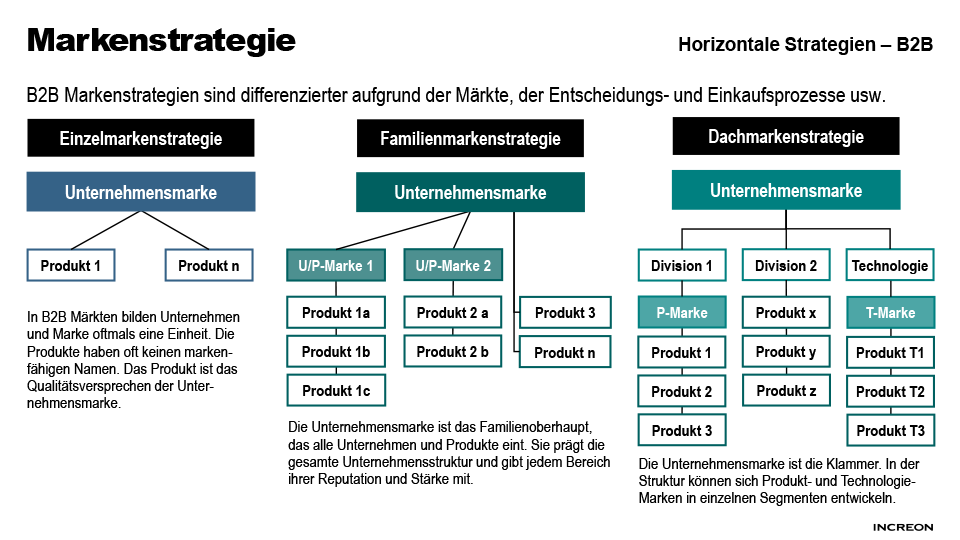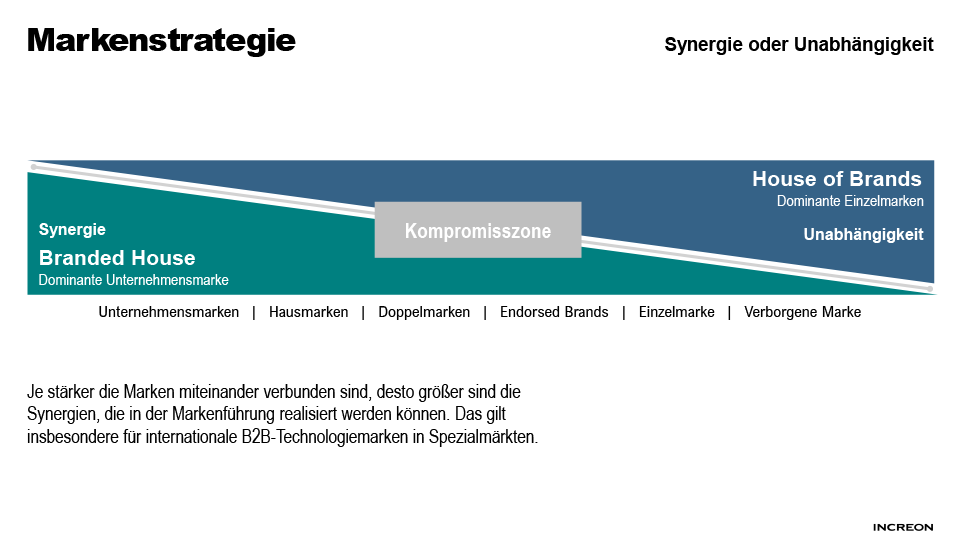

Brand Strategy
In brand consulting, we are sparring partners for international B2B brands owing to our deep understanding of technology, processes and sales — in the development of the brand strategy, at the corporate strategy level, in the lines of business, and the functional levels. The brand strategy is the way to achieve long-term brand goals.

THE BRAND STRATEGY INSPIRES THE CORPORATE STRATEGY.
It gives the latter a face.
The brand strategy is closely linked to the longer-term orientation of the company, to the corporate strategy. When the two strategies complement each other, they inspire corporate development, giving the long-term strategy a face. Brand identity and brand positioning are unmistakable, brand messages are lived by employees and get through to customers, and brand loyalty grows. The brand strategy therefore plays a key role in the development of a B2B brand which is geared to the future and has a long-lasting effect.
A new brand strategy needs time to take effect!
The initial situation and the unique company goals shape the possibilities for developing your B2B brand. Triggers are technological leaps, product innovations, new strategic business areas, acquisitions or revisions, and restructuring in order to keep up with the market. This takes time. It takes three to five years to plan, develop, and implement a brand strategy that fits your goals.
Industrial companies and technology brands usually compete horizontally with competitors who meet similar or the same customer needs with similar or the same products. What are the options for their brand strategies?
In brand consulting for B2B brands, we do not work with the classic strategy approaches that apply to B2C markets. Of course, we also talk about single brand strategy, family brand strategy, and umbrella brand strategy. But experience shows that in industrial and technology companies, different approaches are necessary owing to the differentiated market situations and heterogeneous target groups on the side of the decision-makers.

Christina Bastl
Brand Consulting
Brand strategies go hand in hand with business development and vice versa. Are you aware of the development opportunities?
Single brand strategy in B2B markets — company and brand are one unit.
In the single brand strategy, each service is offered under the one brand. In B2B markets, in which industrial companies focus on special offers as well as services and are suppliers to OEMs, the perception of the brand and the company merges. The product is the quality promise of the corporate brand. Often key products do not even have a product name that speaks for itself. Company and brand are one!
Family brand strategy in B2B markets — reputation, strengths, and values are given.
The corporate brand is the head of the family. The corporate brand shapes the entire corporate structure with its brand identity and brand values. High-performance products and product groups can develop within this structure. New product launches benefit from existing confidence in their B2B brand. Individual products and product groups may have the potential to become businesses in their own right within the family structure. However, the family brand is carried along in all situations and in all markets. In the process, the family brand can sometimes appear more visible, sometimes more withdrawn. In any case, the family brand passes on its reputation, strength, and values to all family members.
Umbrella brand strategy in B2B markets — serving differentiated markets with a clear structure.
Industrial and technology companies grow through product developments, innovations, entry into new market fields, or diversification. For a long time, they carry all products and services under one corporate brand and finally realize that the range of services on offer in the market is becoming diluted. The name and the reputation built up with it should not be softened in the future with an adapted brand strategy. In terms of corporate strategy, it makes sense to structure the company into divisions according to service competencies or special technology fields. Profiled product brands or technology brands can develop under the umbrella brand and there is scope for acquisitions to integrate established B2B product brands into the company’s own portfolio.
FROM BRAND STRATEGY TO BRAND ARCHITECTURE
The brand strategy forms a foundation. It must be implemented and made visible. Brand strategy in the strategic sense and in the sense of visible brand presence must be brought together. The brand architecture shows the categorization of the brands, their respective positions, and the relationship between the brands and their position in the market.
The approaches lie between two concepts: “branded house” with a dominant corporate brand and “house of brands” with dominant individual brands. The more closely the brands are linked, the greater the synergies that can be achieved in brand management. This applies in particular to international B2B technology brands in specialized markets.
Brand architectures are developed on the basis of corporate and brand strategy in pure form or in mixed forms. The long-term strategic orientation of the corporate brand must be included in the decision-making horizon. This is a particularly relevant dimension in corporate structures that are aimed at B2B markets.






